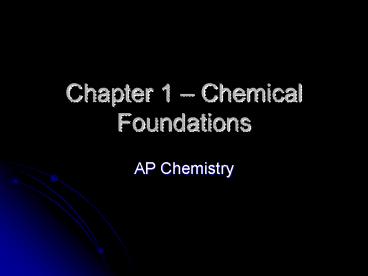Chapter 1 Chemical Foundations - PowerPoint PPT Presentation
1 / 17
Title:
Chapter 1 Chemical Foundations
Description:
mole. amount. A. ampere. electric current. K. kelvin. temperature. s. second. time. m. meter. length ... Use the equivalence statement that relates the two units ... – PowerPoint PPT presentation
Number of Views:112
Avg rating:3.0/5.0
Title: Chapter 1 Chemical Foundations
1
Chapter 1 Chemical Foundations
- AP Chemistry
2
Goals 1 9
- Differentiate between the term theory and law.
- Differentiate between physical and chemical
properties. - Differentiate between physical and chemical
changes. - Understand uncertainty in measurement.
- Determine significant figures from measurements
and apply these values in calculations. - Explain the difference between accuracy and
precision. - Explain the difference between random error and
systematic error. - Use dimensional analysis to convert between
different units of measure. - Classify matter as an element, compound, or
mixture.
3
What is Chemistry?
- Study of the structure, properties, and
composition of matter, and the changes that
substances undergo - Study of matter and change
4
How is Chemistry Done?
- The Scientific Method
- Making observations (collecting data)
- Making a prediction (hypothesis)
- Doing experiments to test the prediction
5
Scientific Method Leads to
- Theory - model attempting to explain natural
phenomena - Natural law summary of observed behavior
- TWO VERY DIFFERENT OUTCOMES!
6
How are Observations Made?
- Qualitative Observations descriptive,
nonnumerical results - EX blue, hot, large
- Quantitative Observations numerical observation
including a scale - EX 1.0 m, 100 K
7
Units of Measurement
- Fundamental SI Units (know the prefixes on p. 9)
8
Precision vs. Accuracy
- Accuracy agreement of a value with the true
value - Precision degree of agreement among several
measurements of the same quantity
9
Types of Error
- Random error measurement has an equal
probability to be high or low - Systematic error measurement is always either
high or low
10
Uncertainty in Measurement
- Every Measurement has some degree of uncertainty
- Uncertainty is accounted for by always recording
certain digits and the first uncertain digit - These numbers are called significant figures
11
How are Significant Figures Determined?
- Nonzero integers are always significant
- Zeros
- Leading zeros are never significant
- Captive zeros are always significant
- Trailing zeros are significant if the number
contains a decimal point - Exact numbers are infinitely significant
- Seek handout for additional practice
12
Significant Figures in Calculations
- Multiplication or Division
- The number of significant figures in the result
is the same as the number in the least precise
measurement used in the calculation - Addition or Subtraction
- The result has the same number of decimal places
as the least precise measurement in the
calculation
13
Dimensional Analysis
- Method used to convert from one unit to another
- Steps
- Use the equivalence statement that relates the
two units - Derive the appropriate unit factor to cancel the
unwanted units - Multiply the quantity to be converted by the unit
factor to give the quantity with the desired units
14
Classification of Matter
- Matter anything occupying space and having mass
- States of Matter solid, liquid, gas
15
Mixtures
- Variable composition
- Homogeneous visibly indistinguishable parts
(solution) - Heterogeneous visibly distinguishable parts
16
Separating Mixtures
- Mixtures can be separated into pure substances
using physical changes - Physical change change in form, not chemical
composition - Pure substance constant composition (elements
and compounds)
17
Separating Compounds
- Compound substance with constant composition
that can be broken down into elements by chemical
processes - Chemical change change resulting in a new
substance































